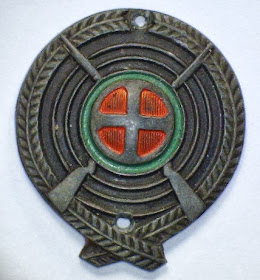Military Training In Germany Badge for Italian Personnel – Silver, Gold
Class.
Instituted on. 15th
July1944
Numbers awarded were;Rarity – Very Rare, Extremely Rare
Known Makers. Unmarked
Military Training In Germany Badge for Italian Personnel - Silver - Obverse.
Military Training In Germany Badge for Italian Personnel - Gold - Obverse.
This award was instituted on 15th
July1944. It consists of a pair of crossed swords, which have double-edged
blades that widen to the tip. They have
plain hilts with rounded pommels and thick plain cross-guards. The blade has a raised central spine. They measure 54 mm from pommel to tip. At the centre is superimposed a vertical
fasces with a swastika superimposed on to it.
From either side of the fasces is a single oak leaf with an elongated
stalk protruding from beneath the lower edges of the blades of the swords. The outline of the leaves is pierced.
The reverse of the badge is plain
with a horizontal safety pin type of attachment. This is secured to the reverse by a round
plate in the example used for this description, but other methods were
employed. The overall colour is of
patinated silver. The Gold form is also
artificially patinated. One cautionary
note to collectors is that this badge has been heavily copied, mainly in
aluminium and great care has to be exercised in the purchase of this rare
badge.
Many Italian units that did not
accept the armistice went on to fight on the German side. This created on 9th
September 1943 the new Republican Army. The Official foundation of the Armed
Forces of the "Repubblica Sociale Italiana (RSI)" was on 28th October
1943. Four Infantry Divisions were formed, namely the "Italia,"
"Littorio," "San Marco" and "Monterosa"
Divisions. The badge was to recognise those Italians who underwent military
training in Germany and was rendered to those soldiers of the four RSI
Divisions and their German instructors. In accordance to the Italian Decree,
Circular no. 160:"Giornale Militare Ufficiale" dated 1944: "In
order to cement more and more comradeship ties with the allied army, the Duce
has authorized a special badge to be issued to the soldiers of the Divisions
under training and to their instructors." The badge was to be given to
NCOs and privates in silver with Officers in Gold. The exact criteria for the
award of the badge are unknown but it is believed that it was for three months
instruction and was for young volunteers who underwent their basic training at
the special training schools, and successfully completed the course, which is
believed to have encompasses infantry, motorised armoured infantry and, in some
cases, heavy armoured training. It is
presumed to equate to the other training school badges and loosely to the
Germanic SS proficiency runes, bronze and silver.
The badge has also been called
the, 'San Marco Badge'. An entry in the pay
book of an Italian in the Germany Army described the badge as, 'Truppenabzeichen
der Zweiten Italienen Divission San Marco in Silber'. The award was worn above the right breast
pocket.
Military Training In Germany Badge for Italian Personnel - Citation.
Military Training In Germany Badge for Italian Personnel in wear.
Military Training In Germany Badge for Italian Personnel in wear.
Military Training In Germany Badge for Italian Personnel in wear.
Military Training In Germany Badge for Italian Personnel in wear.
Military Training In Germany Badge for Italian Personnel - Silver - Obverse - Fake.
Military Training In Germany Badge for Italian Personnel - Silver - Reverse - Fake.
Military Training In Germany Badge for Italian Personnel - Gold - Obverse - Fake.
Military Training In Germany Badge for Italian Personnel - Silver - Obverse - Fake.
Military Training In Germany Badge for Italian Personnel - Silver - Obverse - Fake.
Military Training In Germany Badge for Italian Personnel - Silver - Obverse - Fake.
Military Training In Germany Badge for Italian Personnel - Silver - Obverse - Fake.
Military Training In Germany Badge for Italian Personnel - Silver - Obverse - Fake.



















































